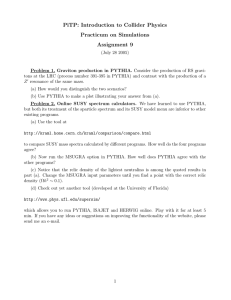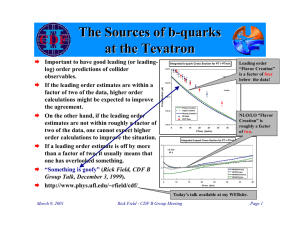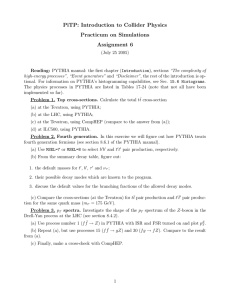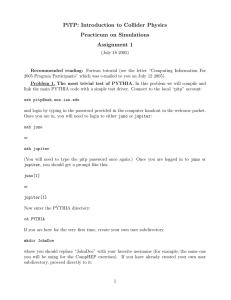The Sources of b-quarks at the Tevatron
advertisement
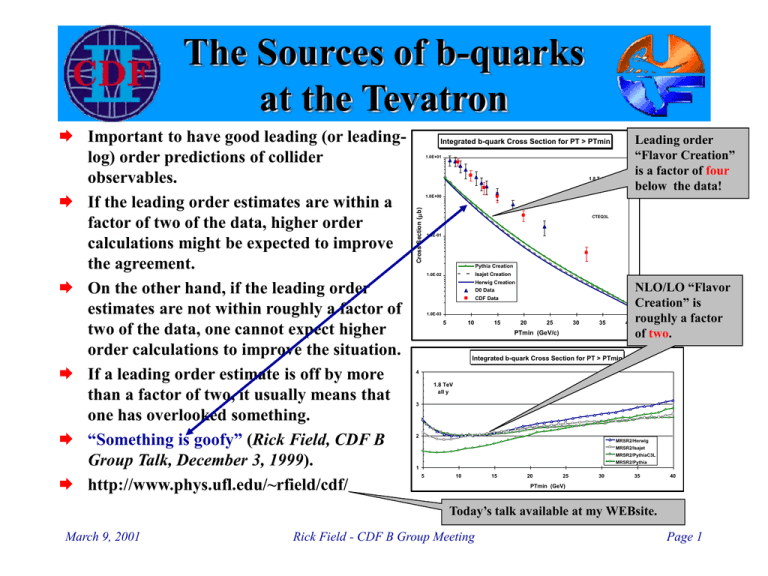
The Sources of b-quarks at the Tevatron Leading order “Flavor Creation” is a factor of four below the data! Integrated b-quark Cross Section for PT > PTmin 1.0E+01 1.8 TeV |y| < 1 1.0E+00 Cross Section (b) Important to have good leading (or leadinglog) order predictions of collider observables. If the leading order estimates are within a factor of two of the data, higher order calculations might be expected to improve the agreement. On the other hand, if the leading order estimates are not within roughly a factor of two of the data, one cannot expect higher order calculations to improve the situation. If a leading order estimate is off by more than a factor of two, it usually means that one has overlooked something. “Something is goofy” (Rick Field, CDF B Group Talk, December 3, 1999). http://www.phys.ufl.edu/~rfield/cdf/ CTEQ3L 1.0E-01 Pythia Creation Isajet Creation 1.0E-02 NLO/LO “Flavor Creation” is 40 roughly a factor of two. Herwig Creation D0 Data CDF Data 1.0E-03 5 10 15 20 25 30 35 PTmin (GeV/c) Integrated b-quark Cross Section for PT > PTmin 4 1.8 TeV all y 3 2 MRSR2/Herwig MRSR2/Isajet MRSR2/PythiaC3L MRSR2/Pythia 1 5 10 15 20 25 30 35 40 PTmin (GeV) Today’s talk available at my WEBsite. March 9, 2001 Rick Field - CDF B Group Meeting Page 1 “Flavor Creation” “Flavor Creation” Integrated b-quark Cross Section for PT > PTmin b-quark 1.0E+01 Proton AntiProton Underlying Event 1.8 TeV |y| < 1 Underlying Event Initial-State Radiation Cross Section (b) 1.0E+00 b-quark “Flavor Creation” corresponds to the production of a b-bbar pair by gluon fusion or by annihilation of light quarks. CTEQ3L 1.0E-01 Pythia Creation Isajet Creation 1.0E-02 Herwig Creation D0 Data CDF Data Leading-Log order “Flavor Creation” is a factor of four below the data! 1.0E-03 5 10 15 20 25 30 35 40 PTmin (GeV/c) Data from CDF and D0 for the integrated b-quark total cross section (PT > PTmin, |y| < 1) for proton-antiproton collisions at 1.8 TeV compared with the QCD Monte-Carlo model predictions of HERWIG, PYTHIA, and ISAJET for the “flavor creation” subprocesses. The parton distribution functions CTEQ3L have been used for all three Monte-Carlo models. . March 9, 2001 Rick Field - CDF B Group Meeting Page 2 Other Sources of b-quarks “Flavor Excitation” Proton “Parton Shower/Fragmentation” b-quark AntiProton Underlying Event Underlying Event b-quark Initial-State Radiation Proton AntiProton Underlying Event Underlying Event Initial-State Radiation gluon, quark, or antiquark b-quark b-quark “Flavor Excitation” corresponds to the scattering of a b-quark (or bbar-quark) out of the initial-state into the final-state by a gluon or by a light quark or antiquark. The b-bbar pair is created within a parton shower or during the the fragmentation process of a gluon or a light quark or antiquark. Here the QCD hard 2-to-2 subprocess involves gluons and light quarks and antiquarks. This includes what is referred to as “gluon splitting”. “Flavor excitation” is, of course, very sensitive to the number of b-quarks within the proton (i.e. the structure functions). The Monte-Carlo models predictions for the “shower/fragmentation” contribution differ considerably. This is not surprising since ISAJET uses independent fragmentation, while HERWIG and PYTHIA do not; and HERWIG and PYTHIA modify the leading-log picture of parton showers to include “color coherence effects”, while ISAJET does not. March 9, 2001 Rick Field - CDF B Group Meeting Page 3 Inclusive b-quark Cross Section Integrated b-quark Cross Section for PT > PTmin Integrated b-quark Cross Section for PT > PTmin 1.0E+02 1.0E+02 Pythia CTEQ3L Pythia GRV94L Pythia Creation Pythia Creation Pythia Excitation 1.0E+01 Pythia Excitation 1.0E+01 Pythia Fragmentation Pythia Fragmentation D0 Data CDF Data Cross Section (b) Cross Section (b) D0 Data 1.0E+00 1.0E-01 1.0E-01 1.8 TeV |y| < 1 1.8 TeV |y| < 1 1.0E-02 CDF Data 1.0E+00 1.0E-02 1.0E-03 1.0E-03 5 10 15 20 25 30 35 40 5 10 PTmin (GeV/c) 15 20 25 30 35 40 PTmin (GeV/c) Data on the integrated b-quark total cross section (PT > PTmin, |y| < 1) for proton-antiproton collisions at 1.8 TeV compared with the QCD Monte-Carlo model predictions of PYTHIA (CTEQ3L) and PYTHIA (GRV94L). The four curves correspond to the contribution from flavor creation, flavor excitation, shower/fragmentation, and the resulting total. March 9, 2001 Rick Field - CDF B Group Meeting Page 4 Inclusive b-quark Cross Section Integrated b-quark Cross Section for PT > PTmin Integrated b-quark Cross Section for PT > PTmin 1.0E+02 1.0E+02 Herwig CTEQ3L Isajet CTEQ3L Herwig Creation Isajet Creation Isajet Excitation Isajet Fragmentation Herwig Fragmentation D0 Data D0 Data CDF Data 1.0E+00 1.0E-01 1.8 TeV |y| < 1 1.0E-02 Herwig Excitation 1.0E+01 Cross Section (b) Cross Section (b) 1.0E+01 CDF Data 1.0E+00 1.0E-01 1.8 TeV |y| < 1 1.0E-02 1.0E-03 1.0E-03 5 10 15 20 25 30 35 40 5 10 15 20 25 30 35 40 PTmin (GeV/c) PTmin (GeV/c) Data on the integrated b-quark total cross section (PT > PTmin, |y| < 1) for proton-antiproton collisions at 1.8 TeV compared with the QCD Monte-Carlo model predictions of ISAJET (CTEQ3L) and HERWIG (CTEQ3L). The four curves correspond to the contribution from flavor creation, flavor excitation, shower/fragmentation, and the resulting total. March 9, 2001 Rick Field - CDF B Group Meeting Page 5 Inclusive b-quark Cross Section Integrated b-quark Cross Section for PT > PTmin Integrated b-quark Cross Section for PT > PTmin 1.0E+01 1.0E+01 1.8 TeV |y| < 1 1.8 TeV |y| < 1 1.0E+00 Cross Section ( b) Cross Section (b) 1.0E+00 CTEQ3L 1.0E-01 CTEQ3L 1.0E-01 1.0E-02 1.0E-02 Pythia Excitation Pythia Fragmentation Isajet Excitation Isajet Fragmentation Herwig Excitation Herwig Fragmentation 1.0E-03 1.0E-03 5 10 15 20 25 30 35 40 5 10 PTmin (GeV/c) 15 20 25 30 35 40 PTmin (GeV/c) Predictions of HERWIG, PYTHIA, and ISAJET for the integrated b-quark total cross section (PT > PTmin, |y| < 1) for proton-antiproton collisions at 1.8 TeV resulting from “flavor excitation” and “shower/fragmentation”. The parton distribution functions CTEQ3L have been used for all three Monte-Carlo models . March 9, 2001 Rick Field - CDF B Group Meeting Page 6 Inclusive b-quark Cross Section Integrated b-quark Cross Section for PT > 5 GeV/c |Y| < 1 Integrated b-quark Cross Section for PT > 5 GeV/c |Y| < 1 25 12 1.8 TeV 1.8 TeV 10 15 Fragmentation Flavor Excitation Flavor Creation 10 Cross Section (b) Cross Section (b) 20 8 Fragmentation 6 Flavor Excitation Flavor Creation 4 5 2 0 0 Isajet CTEQ3L Herwig CTEQ3L Pythia CTEQ3L Herwig DO1.1 Pythia GRV94L Isajet CTEQ3L Herwig CTEQ3L Pythia CTEQ3L Predictions of ISAJET (CTEQ3L), HERWIG (CTEQ3L), PYTHIA (CTEQ3L), HERWIG (DO1.1), and PYTHIA (GRV94L) for the integrated b-quark total cross section (PT > 5 GeV/c, |y| < 1) for proton-antiproton collisions at 1.8 TeV. The contributions from flavor creation, flavor excitation, and shower/fragmentation are shown together with the resulting sum (overall height of box). The differences in the flavor excitation contribution are due to the different ways the models handle the b-quark mass in this subprocess. However, it seems likely that at the Tevatron the flavor excitation contribution to the b-quark cross section is comparable to or greater than the contribution from flavor creation. The QCD Monte-Carlo predictions differ considerably for the “shower/fragmentation” contribution. However, at the Tevatron the fragmentation contribution to the b-quark cross section might be comparable to the contribution from flavor creation. March 9, 2001 Rick Field - CDF B Group Meeting Page 7 b-quark Rapidity Distribution b-quark Rapidity Distribution PT > 5 GeV/c b-quark Rapidity Distribution PT > 5 GeV/c 8 8 1.8 TeV 1.8 TeV 6 d/dY (b) d/dY (b) 6 4 2 4 2 0 0 -5 -4 -3 -2 -1 0 1 2 3 4 5 -5 -4 -3 -2 -1 Rapidity Y 0 1 2 3 4 5 Rapidity Y Pythia CTEQ3L Pythia Creation Herwig CTEQ3L Herwig Creation Pythia Excitation Pythia Fragmentation Herwig Excitation Herwig Fragmentation Predictions of PYTHIA (CTEQ3L), and HERWIG (CTEQ3L) for the b-quark rapidity distribution (PT > 5 GeV/c) for proton-antiproton collisions at 1.8 TeV. The four curves correspond to the contribution from flavor creation, flavor excitation, shower/fragmentation, and the resulting total. March 9, 2001 Rick Field - CDF B Group Meeting Page 8 Simple Correlations b-quark direction b-quark Correlations PT > 5 GeV/c |y|<1 Df 50% Pythia (CTEQ3L) 1.8 TeV 40% Percent of Events “Toward” “Away” 30% Away Toward 20% 10% bbar-quark 0% Flavor Creation Flavor Excitation Fragmentation For events with a b-quark (PT > 5 GeV/c |y|<1), probability of observing a bbar-quark (PT > 5 GeV/c |y|<1). Predictions of PYTHIA (CTEQ3L) for the probability of finding a bbar-quark with PT > 5 GeV/c and |y|<1 for events with a b-quark with PT > 5 GeV/c and |y|<1 for proton-antiproton collisions at 1.8 TeV. The contribution from the “toward” (|Df|<90o) and the “away” (|Df|>90o) region of the bquark are shown for flavor creation, flavor excitation, and shower/fragmentation. March 9, 2001 Rick Field - CDF B Group Meeting Page 9 Simple Correlations b-quark Correlations PT > 5 GeV/c |y|<1 50% q-quark Correlations PT > 5 GeV/c |y|<1 40% 30% Away Toward 20% Percent of Events Percent of Events 40% 30% Away Toward 20% 10% 10% 0% 0% Flavor Creation Isajet (CTEQ3L) 1.8 TeV 50% Herwig (CTEQ3L) 1.8 TeV Flavor Excitation Fragmentation Flavor Creation Flavor Excitation Fragmentation Predictions of HERWIG (CTEQ3L) and ISAJET (CTEQ3L) for the probability of finding a bbarquark with PT > 5 GeV/c and |y|<1 for events with a b-quark with PT > 5 GeV/c and |y|<1 for proton-antiproton collisions at 1.8 TeV. The contribution from the “toward” (|Df|<90o) and the “away” (|Df|>90o) region of the b-quark are shown for flavor creation, flavor excitation, and shower/fragmentation. March 9, 2001 Rick Field - CDF B Group Meeting Page 10 b-quark Inclusive versus Pair Cross Section b-quark Inclusive versus Pair Cross Section b-quark Correlations PT1 > 6.5 GeV/c 35% 100.0 1 = b-quark 2 = bbar-quark 1.8 TeV 30% CDF Data Probability of Anti-b Quark b-quark Inclusive Cross Section PT1 > Ptmin |Y1|<1 Cross Section (b) CDF Data 1.8 TeV 1 10.0 25% 20% 15% 10% 1 = b-quark 2 = bbar-quark PT1 > 6.5 GeV PT2 > PT2min |Y1|<1 |Y2|<1 5% 1.0 0% Pair Cross Section PT1 > 6.5 GeV PT2 > PTmin |Y1|<1 |Y2|<1 2 0 10 15 20 PT2min 0.1 5 5 10 15 20 Divide the pair cross section 2 by the single inclusive cross section 1. PTmin (GeV/c) Data from CDF on the single b-quark inclusive cross section and the b-bbar pair cross section at 1.8 TeV. March 9, 2001 Rick Field - CDF B Group Meeting Page 11 Integrated Pair Cross Section Integrated Pair Cross Section for PT2 > PT2min b-quark Correlations PT1 > 6.5 GeV/c 1.0E+02 60% Pythia CTEQ3L 1.8 TeV 1.8 TeV Pythia Creation Pythia CTEQ3L 50% Pythia Creation Pythia Excitation Pythia Excitation Pythia Fragmentation Probability of Anti-b Quark Pythia Fragmentation 1.0E+01 Cross Section (b) CDF Data 1.0E+00 CDF Data 40% 1 = b-quark 2 = bbar-quark PT1 > 6.5 GeV PT2 > PT2min |Y1|<1 |Y2|<1 30% 20% 1.0E-01 10% 1 = b-quark 2 = bbar-quark PT1 > 6.5 GeV/c PT2 > PT2min |y1| < 1 |y2| < 1 1.0E-02 0% 0 5 10 15 20 PT2min 1.0E-03 0 5 10 15 20 PT2min (GeV/c) Data from CDF on the b-bbar pair cross section and the b-bbar probability at 1.8 TeV compared with the QCD Monte-Carlo predictions of PYTHIA (CTEQ3L). The four curves correspond to the contribution from flavor creation, flavor excitation, shower/fragmentation, and the resulting total. March 9, 2001 Rick Field - CDF B Group Meeting Page 12 Azimuthal Correlations b-bbar Correlations: Azimuthal Df Distribution b-quark direction 0.07 Df 1.8 TeV 1 = b-quark 2 = bbar-quark PT1 > 5 GeV PT2 > 0 |Y1|<1 |Y2|<1 0.06 “Toward” d/df (b/deg) 0.05 “Away” 0.04 0.03 "Toward" "Away" 0.02 bbar-quark 0.01 0.00 0 30 60 90 120 150 180 Df (degrees) Pythia CTEQ3L Pythia Creation Pythia Excitation Pythia Fragmentation QCD Monte-Carlo predictions of PYTHIA (CTEQ3L) for the b-bbar pair azimuthal cross section d/df for |y|<1. The four curves correspond to the contribution from flavor creation, flavor excitation, shower/fragmentation, and the resulting total at 1.8 TeV. March 9, 2001 Rick Field - CDF B Group Meeting Page 13 b-quark Inclusive versus Pair Cross Section Integrated Pair Cross Section for PT2 > PT2min Integrated b-quark Cross Section for PT > PTmin 1.0E+02 1.0E+02 Pythia CTEQ3L (fudged) Pythia CTEQ3L (fudged) 1.8 TeV Pythia Creation (x2) Pythia Creation (x2) 1.0E+01 Pythia Excitation 1.0E+01 Pythia Excitation Pythia Fragmentation Cross Section (b) Cross Section (b) Pythia Fragmentation D0 Data 1.0E+00 CDF Data 1.0E-01 1.8 TeV |y| < 1 1.0E-02 CDF Data 1.0E+00 1.0E-01 1 = b-quark 2 = bbar-quark PT1 > 6.5 GeV/c |y1| < 1 |y2| < 1 1.0E-02 1.0E-03 1.0E-03 5 10 15 20 25 30 35 40 0 5 10 15 20 PT2min (GeV/c) PTmin (GeV/c) Data from CDF on the single b-quark inclusive cross section and the b-bbar pair cross section at 1.8 TeV compared with the QCD Monte-Carlo predictions of PYTHIA (CTEQ3L) where the flavor creation term has been multiplied by a factor of 2 to take into account higher order corrections. March 9, 2001 Rick Field - CDF B Group Meeting Page 14 Summary & Conclusions “Flavor Creation” Proton “Flavor Excitation” b-quark AntiProton Underlying Event Underlying Event Initial-State Radiation b-quark Proton “Parton Shower/Fragmentation” b-quark AntiProton Underlying Event Underlying Event Proton AntiProton Underlying Event Underlying Event b-quark Initial-State Radiation Initial-State Radiation gluon, quark, or antiquark b-quark b-quark All three sources are important at the Tevatron! One should not take the QCD Monte-Carlo model estimates of “flavor excitation” and “shower/fragmentation” too seriously. The contributions from these subprocesses are very uncertain and more work needs to be done. There are many subtleties! However, it seems likely that all three sources are important at the Tevatron. In Run II we should be able experimentally to isolate the individual contributions to b-quark production by studying b-bbar correlations in detail. March 9, 2001 Rick Field - CDF B Group Meeting Page 15
